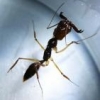I found these tiny, tiny ants in my backyard, under a fallen window screen, beneath some dead leaves. There are a lot of oak trees in my yard, but these girls were next to a jelly palm. The queen was right under the screen and a single leaf; I didn't see any tunnels or holes in the ground. I couldn't find any eggs or larvae (other than a single egg being carried by a worker). They aren't very fast, but they were definitely active.
I have no reliable way to measure the queen's length, but I'd guess she's around 5-7mm long. I put a penny in my pictures to help for size referencing.
The workers look entirely brown; the majors and the queen have very dark (black) heads and gasters. I'm pretty sure this is a Pheidole species, but if anyone has any guesses as to what they are, exactly, I'd appreciate it. I'd love any tips for taking care of them; I like polymorphic species. I already have a 117colonies formicarium on the way that was going to be used for my Trachymyrmex septentrionalis colony, but they're fine as they are.
I apologize for the blurry pictures; these were taken with my Android Turbo phone camera.
http://www.formicult...rgia-—-2232017/

















